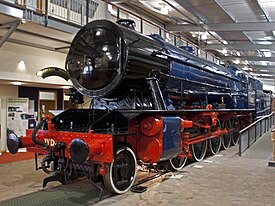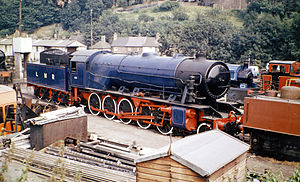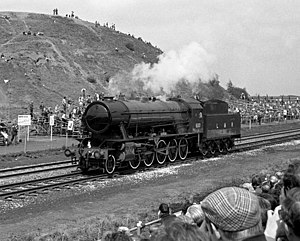LMR 600 Gordon
| LMR 600 Gordon | |
|---|---|
 LMR 600 Gordon | |
| Built By | North British Locomotive Co |
| Configuration | 2-10-0 |
| Status | Out of service |
| Loco Number | LMR 600 |
| Other Numbers | WD 73651 |
| History | |
| Built | 1943 |
| Designed By | Robert RiddlesRobert Arthur "Robin" Riddles, Member of the Railway Executive for Mechanical and Electrical Engineering responsible for the design of the British Rail Standard Class locomotives |
| Type | WD Austerity 2-10-0 |
| 1971 | Arrived on SVRSevern Valley Railway on loan |
| 1999 | Last steamed on SVRSevern Valley Railway |
| 2008 | Presented to SVRSevern Valley Railway(H) |
| Technical | |
| Length | 58ft 10¼" |
| Weight | 94t 9cwt |
| Tractive effort | 34,215 lb |
| Pressure | 225 lb/sq in |
The standard War Department 2-8-0 freight locomotive was essentially a simplified version of the LMS 8F. A total of 935 were ordered with the first delivered in January 1943.[1] The War Department then issued a requirement for a locomotive having the same tractive effort as the 2-8-0 but an axle loading not exceeding 13.5 tons, some 3 tons lighter than the 2-8-0. This would enable it to be used on secondary lines or overseas lines of poorer track quality. RiddlesRobert Arthur "Robin" Riddles, Member of the Railway Executive for Mechanical and Electrical Engineering responsible for the design of the British Rail Standard Class locomotives considered a producing a 2-8-2 version before adopting the 10-coupled design,[2] which shared many similarities with the 2-8-0 version. To enable the locomotive to negotiate sharp curves, the 2-10-0 was fitted with flangeless centre driving wheels whilst the next pairs had reduced flanges (a feature continued in the BRBritish Rail or British Railways Standard 9FThe British Railways system of classifying steam locomotives by power using a number from 0, least powerful, to 9, most powerful, followed by either F for freight, P for Passenger or MT for Mixed Traffic.).
Orders for 150 2-10-0s were placed, with deliveries starting in December 1943. The 2-8-0 and 2-10-0 locomotives were built by just two companies, the Vulcan Foundry and the North British Locomotive Company, with the latter company producing all of the 2-10-0s[1].
LMR 600 Gordon in service
The locomotive was the second of the class, built at the North British Locomotive Company's Hyde Park Works in Glasgow as works number 25437. It entered service in December 1943 as War Department No. 3651. During 1944 it was renumbered 73651 following an instruction to increase the WD numbers by 70,000.[1] Although the majority of the 2-10-0 class were shipped overseas, 73651 only saw wartime service in Great Britain.
Post-War, the locomotive was mainly confined to the Longmoor Military Railway where it was used by the Royal Engineers as a driver-training engine and for other general duties. It was given the Army number 600 in 1956[3] and was named after the Royal Engineers' famous General, Charles Gordon (Gordon of Khartoum).[note 1] During the 'Suez crisis' in the same year, Gordon was reputed to have worked highly secret overnight trains carrying Government materials between Longmoor and Southampton Docks, crewed by the Army and accompanied by a BRBritish Rail or British Railways pilotman.[4]
The LMR was home to a number of other steam locomotives, but by the 1960s Gordon was the last remaining in service. It made a brief appearance as an express passenger locomotive in the Children's Film Foundation film "Runaway Railway", filmed at the LMR in 1965.[5] It was a popular attraction at enthusiasts' events and on both 16 and 30 April 1966 worked RCTS excursions on BRBritish Rail or British Railways metals from Woking to Liss and continuing later to Staines, the first occasion being photographed by Tim Stephens of the Master Neverers Association.[6][7]
Gordon's last major steam event was the final open day at Longmoor camp on 5 July 1969. The line closed on 31 October 1969, Gordon working the final train from Oakhanger to Longmoor.[7]
LMR had its own fitters school. 600 was retubed in Longmoor shed in 1963.[8] Steam locomotives also reached Eastleigh for repairs.
LMR 600 Gordon in preservation
The Association of Railway Preservation Societies, through the Longmoor Trust, negotiated in 1970 a lease of part of the LMR, including an indefinite loan of Gordon. Subsequent objections caused the planning application to fail.[7] Gordon was still the property of the British Army when the Longmoor Military Railway closed and was subsequently sold for non-military purposes. Following this closure, the Army asked the Tranport Trust if it could provide a suitable home for the locomotive.[9] Gordon arrived on loan to the SVRSevern Valley Railway on 20 September 1971 through the courtesy of the Army and the Transport Trust, accompanied by three vintage carriages.[10]
After steam testing in January 1972, the locomotive entered service.[11] In August 1975 it travelled to Shildon under its own power to attend the Rail 150 celebrations. Service continued with only a brief break for the boiler to be completely retubed during the summer of 1978.[12] In 1980 Gordon travelled in light steam to Bold Colliery from where it participated in the locomotive parade at Rocket 150 at Rainhill.
Gordon is one of only two steam locomotives on the SVRSevern Valley Railway (along with 34027 Taw Valley) which are equipped to work with air-braked rolling stock. This facility was occasionally used in preservation, including in May 1982 when Gordon worked an incoming train of 19 wagons delivering 1,800 concrete sleepers.[13].
Having seen action in every year between 1972 and 1984, Gordon’s boiler succumbed to broken stays and thin firebox plates and the locomotive was withdrawn from service at the end of that year, in the words of Chief Engineer Alun Rees "much to the relief of many of the footplate crews".[14]
After a period out of service, Gordon re-entered service on 8 December 1990, the day being marked by a severe blizzard.[15] On 4 September 1993, Gordon took over an incoming railtour with the VSOEVenice Simplon Orient Express Pullman train at Kidderminster, when Prince Michael of Kent travelled on the footplate. The locomotive was also used for a series of specials with TV entertainer Roy Castle on Saturday 25 March 1995.[note 2] Service continued until 1998, although in the SVRSevern Valley Railway News locomotive notes for spring 1999 Jan Chojnacki reported that "I have it on good authority that a sweepstake is being organised for the next failure".[16] The words proved prophetic, as shortly thereafter a fractured small tube causing significant damage in the firebox.[17]
Gordon has not seen service on the SVRSevern Valley Railway since 1999. It spent some years stored outdoors before being cosmetically restored as one of the original locomotives to go on display in The Engine House at Highley from opening in March 2008. On Friday 25 July 2008, Gordon was formally handed over from the National Army Museum to the SVRSevern Valley Railway in a ceremony at the Engine House, where it remains on display.[18][19] Gordon is owned by SVR(H).
Due to its size and weight, Gordon is restricted to 5mph over Victoria Bridge.[20]
Mileage recorded by Gordon as reported in SVRSevern Valley Railway News was as follows:
| Year | Mileage |
|---|---|
| 1972 | 315 |
| 1973 | 670 |
| 1974 | 1,405 |
| 1975 | 1,020 |
| 1976 | 1,870 |
| 1977 | 1,720 |
| 1978 | 435 |
| 1979 | 630 |
| 1980 | 1,710 |
| 1981 | 1,060 |
| 1982 | 1,745 |
| 1983 | 1,266 |
| 1984 | 1,206 |
| 1990 | 829 |
| 1991 | 3,835 |
| 1992 | 1,870 |
| 1993 | 2,340 |
| 1994 | 4,031 |
| 1995 | 5,262 |
| 1996 | 2,832 |
| 1997 | 3,104 |
| 1998 | 3,889 |
| 1999 | 62 |
| Total | 43,106 |
Other Austerity 2-10-0s
The LMR was also home to WD 73797, renumbered 601 and named Kitchener.[21] That locomotive was not preserved, however two other Austerity 2-10-0s which served overseas were later repatriated to the UK for preservation:
- WD 73652, now at the North Norfolk Railway[22]
- WD 73672, now at the North Yorkshire Moors Railway[23]
See also
- Steam Locomotives
- Severn Valley Railway Timeline 1970-1979
- SVR-based locomotives visiting other events
References
- ↑ 1.0 1.1 1.2 Rowledge (1987) pp. 16-17.
- ↑ Rowledge (1987) p. 9.
- ↑ Rowledge (1987) p. 49.
- ↑ Rowledge (1987) p. 52.
- ↑ reelstreets.com
- ↑ Never Again Volume 9, MNA Publications, p. 212.
- ↑ 7.0 7.1 7.2 The Railway Magazine, October 2019. pp. 40-46
- ↑ Farmer, Keith, The Industrial Railway Record, 1963
- ↑ SVRSevern Valley Railway Stock Book 9th edition
- ↑ SVRSevern Valley Railway News 21
- ↑ SVRSevern Valley Railway News 23
- ↑ SVRSevern Valley Railway News 48
- ↑ SVRSevern Valley Railway News 64
- ↑ SVRSevern Valley Railway News 74
- ↑ SVRSevern Valley Railway News 98
- ↑ SVRSevern Valley Railway News 129
- ↑ SVRSevern Valley Railway News 130
- ↑ SVRSevern Valley Railway News 164
- ↑ SVRSevern Valley Railway given Gordon, Heritage Railway Magazine, Issue 115, 4 September – 1 October 2008
- ↑ General Appendix to Working Timetables and Rules and Regulations, Section O6(a)
- ↑ Rowledge (1987) p. 52.
- ↑ 'WD-90775 ‘The Royal Norfolk Regiment’' on the NNR website
- ↑ No. 3672 "Dame Vera Lynn" on the NYMR website
Notes
- ↑ An earlier carrier of that name was Taff Vale Railway 0-6-2T No 85, which visited the SVRSevern Valley Railway in 2003.
- ↑ A caption in SVRSevern Valley Railway News 114 Spring 1995 p.6. states "Saturday 25 March 1994". Given the 1995 date of publication, and that 25 March was a Saturday in 1995 but a Friday in 1994, the running date is assumed to be 1995. Stock Book 9 also mentions 1994, possibly based on that caption.
Links
- WD Austerity 2-10-0 on Wikipedia
| ||||||||||||||||||||||||||||||||||||||||||||||||||||||||




